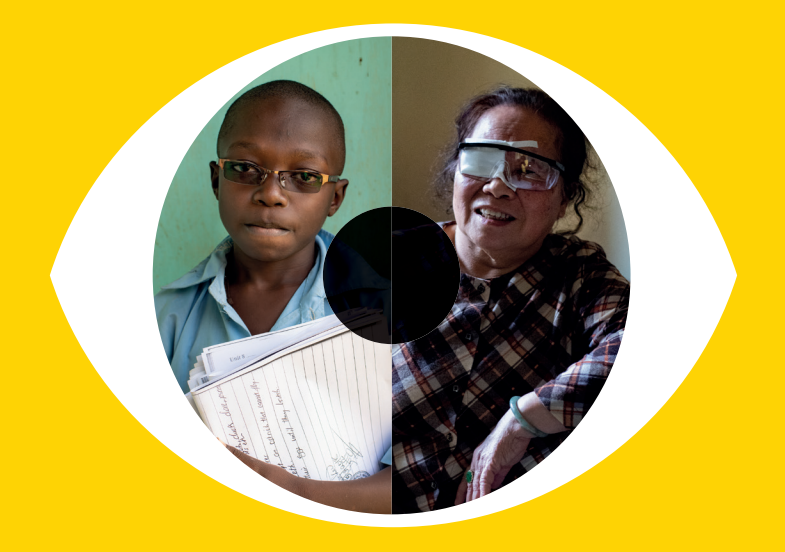By Matthew Burton, Jacqui Ramke and Ian McCormick
Today is World Sight Day, a day to raise global awareness about eye health which asks us to ‘Love Our Eyes’. A new report from the World Health Organization, based on new analyses, extending work from the Lancet Global Health Commission on Global Eye Health, is helping to make this a reality for the hundreds of millions of people worldwide still in need of good quality eye care.
Last May at the Seventy-fourth World Health Assembly, Member States endorsed two new ambitious global eye care targets for 2030:
- A 30-percentage point increase in effective cataract surgical coverage (eCSC) and
- A 40-percentage point increase in effective refractive error coverage (eREC)
Yesterday WHO published a report presenting the first global estimates of these indicators, which will serve as a reference point for countries’ efforts towards meeting these targets. But what do these indicators mean and what is their importance on World Sight Day?
eCSC and eREC
Effective cataract surgical coverage (eCSC) measures the number of people in a population that have been operated for cataract, and had a good outcome, as a proportion of all the people requiring or having received surgery in that population.
Similarly, effective refractive error coverage (eREC) is defined as the proportion of people in need of services for refractive error such as spectacles or contact lenses who have received these interventions and have a resultant good-quality outcome.
Why are these targets important?
There is a huge unmet need for eye care globally. Currently there are 1.1 billion people living with vision loss who are not receiving sufficient care to improve their sight, including 43 million people with blindness. Amazingly, 90% of these people simply need either cataract surgery or spectacles, both of which are existing, highly cost-effective treatments.
eCSC and eREC, which were initially proposed or defined by ICEH team members, therefore help to show how successfully countries are addressing the main causes of vision impairment in their populations. They can also act as proxy indicators for the overall monitoring of Universal Health Coverage (UHC), which aims to ensure all people worldwide can access quality health services. Speaking at the launch of the report Dr Stuart Keel, Technical Officer of the Vision and Eye Care Programme at WHO, said : “These effective coverage indicators are WHO’s preferred indicators to monitor Universal Health Coverage.”
The estimates in this report disaggregate the results by WHO region, sex and World Bank income level, allowing conclusions to be drawn about income and gender inequity. They also capture the quality of the treatments being provided, showing the proportion of people accessing care who obtained a good quality outcome against those who did not.
The first United Nations Resolution on Vision, passed in 2021, requests for these indicators to be considered for the monitoring framework for the Sustainable Development Goals (SDGs) when it is revised in 2025. Recent research has highlighted that eye health is essential to achieving many of the SDGs, meaning these latest estimates will help to establish eCSC and eREC as important indicators for the monitoring of sustainable development.
What does this latest research show?
The estimations of these indicators show large disparities across countries and gender. Country eCSC estimates, in research led by ICEH published this week, ranged from 3.8% (Guinea Bissau) to 70.3% (Hungary), with the highest among high-income countries and lowest in low-income countries. On average, gender disparity was evident, with eCSC higher in men than women.
Estimates of eREC, in research led by the Vision Loss Expert Group, also show considerable variation by region and income, with the lowest in Sub-Saharan Africa. Even in high-income countries effective coverage was lower than ideal (79%). eREC was also higher in men and reduced with increasing age, but has improved for all people globally by 19% between 2000 and 2021.
Overall, these estimates, which are in large part based on Rapid Assessment of Avoidable Blindness surveys, highlight a quality gap, with people in some settings accessing services but not uniformly experiencing good vision, particularly after cataract surgery. Indeed, the eCSC results in some countries suggest that quality should be improved prior to attempts to increase access to surgery. Equity must also be embedded in efforts to improve access to interventions, with a focus on underserved groups.
What can countries do to achieve these targets?
Recent research in global eye health recommends that improvements can be made by integrating eye health into existing health pathways and ensuring that those most in need are properly identified. Technology can be a great to tool to do so, improving access to screening, referral and treatment.
Governments can prioritise eye care through training more personnel and better financing mechanisms for eye health, and by increasing the coverage of survey data. Solution-focused, contextually relevant research is also crucial to improving eye health services.
The report is the work of a collaborative initiative among the eye care field, data centres and WHO. Global networks such as this are essential to providing good quality research to improve eye health for all.
Read more information on improving global eye health here.
Publications
McCormick I, Butcher R, Evans JR, Mactaggart IZ, Limburg H, Jolley E, et al. Effective cataract surgical coverage in adults aged 50 years and older: estimates from population-based surveys in 55 countries. The Lancet Global Health. October 2022. https://doi.org/10.1016/S2214-109X(22)00419-3
Bourne RRA, Cicinelli MV, Sedighi T, Tapply IH, McCormick I, Jonas JB, et al. Effective refractive error coverage in adults aged 50 years and older: estimates from population-based surveys in 61 countries. The Lancet Global Health. October 2022. https://doi.org/10.1016/S2214-109X(22)00419-3
Report of the 2030 targets on effective coverage of eye care: https://www.who.int/publications/i/item/9789240058002

